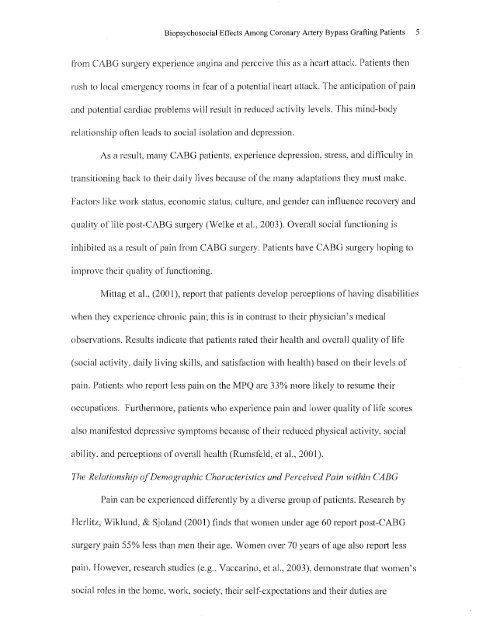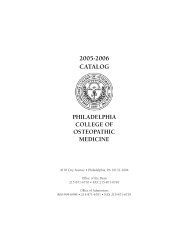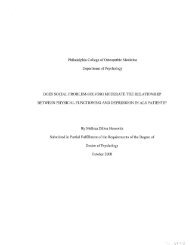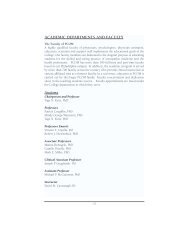0 - Philadelphia College of Osteopathic Medicine
0 - Philadelphia College of Osteopathic Medicine
0 - Philadelphia College of Osteopathic Medicine
Create successful ePaper yourself
Turn your PDF publications into a flip-book with our unique Google optimized e-Paper software.
Biopsychosocial Effects Among Coronary Artery Bypass Grafting Patients<br />
from CABO surgery experience angina and perceive this as a heart attack. Patients then<br />
rush to local emergency rooms in fear <strong>of</strong> a potential heart attack. The anticipation <strong>of</strong> pain<br />
and potential cardiac problems 'will result in reduced activity levels. This mind-body<br />
relationship <strong>of</strong>ten leads to social isolation and depression.<br />
As a result, many CABG patients, experience depression, stress, and difficulty in<br />
transitioning back to their daily lives because <strong>of</strong>the many adaptations they must make.<br />
Factors like \vork status, economic status, culture, and gender can influence recovelY and<br />
quality <strong>of</strong> life post-CABO surgery (Welke et aI., 2003). Overall social functioning is<br />
inhibited as a result <strong>of</strong> pain from CABG surgery. Patients have CABG surgery hoping to<br />
improve their quality <strong>of</strong> functioning.<br />
Mittag et aI., (2001), report that patients develop perceptions <strong>of</strong>having disabilities<br />
\vhen they experience chronic pain; this is in contrast to their physician's medical<br />
observations. Results indicate that patients rated their health and overall quality <strong>of</strong> life<br />
(social activity. daily living skills, and satisfaction with health) based on their levels <strong>of</strong><br />
pain. Patients who report less pain on the MPQ are 33% more likely to resume their<br />
occupations. Furthennore, patients who experience pain and lower quality <strong>of</strong> life scores<br />
also manifested depressive symptoms because <strong>of</strong>their reduced physical activity, social<br />
ability. and perceptions <strong>of</strong> overall health (Rumsfeld, et aI., :20(1).<br />
The Relationship qfDemographic Characteristics and Perceived Pain within CABG<br />
Pain can be experienced differently by a diverse group <strong>of</strong> patients. Research by<br />
Berlitz, Wiklund, & Sjoland (2001) finds that women under age 60 report post-CABG<br />
surgery pain 55% less than men their age. Women over 70 yem's <strong>of</strong> age also fepOli less<br />
pain. However, resem'ch studies (e.g .. Vaccarino, et ai., 2003), demonstrate tl1at women's<br />
social roles in the home. work, society, their self-expectations and their duties are<br />
5






